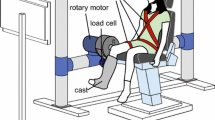Abstract
Joint position sense (JPS), one method to assess proprioception, is the ability to replicate a target limb position. Feedback is commonly used to improve motor performance but it has not been demonstrated to improve JPS. The purpose of this study was to determine if feedback decreases error associated with knee JPS at three movement velocities. Healthy volunteers sat with their hip and knees flexed. The knee was passively extended at three velocities (0.5, 2, and 10°/s). Subjects were instructed to stop knee motion, via a thumb switch, at a 20° knee flexion target. Following movement, each subject received visual and proprioceptive feedback indicating final leg position relative to the target position. Movement velocities and times (4 s, 5 s, 6 s) were randomly presented so subjects could not predict the target position. Measures of JPS included constant error (CE), absolute error (AE), variable error (VE), and percent correct (%CORR). Significant decreases in CE, AE, and VE as well as an increase in %CORR were demonstrated. The majority of JPS improvement (85%) occurred by the tenth trial. Short-term improvements in JPS may be the result of temporary CNS adaptations via feedback that was provided to subjects. Long-term learning of JPS enhancement needs further investigation.




Similar content being viewed by others
References
Ashton-Miller JA, Wojtys EM, Huston LJ, Fry-Welch D (2001) Can proprioception really be improved by exercises? Knee Surg Sports Traumatol Arthrosc 9:128–136
Barrack RL, Skinner HB, Brunet ME, Cook SD (1984) Joint kinesthesia in the highly trained knee. J Sports Med Phys Fitness 24:18–20
Barrack RL, Skinner HB, Brunet ME, Cook SD (1983) Joint laxity and proprioception in the knee. Phys Sportsmed 11:130–135
Borsa PA, Lephart SM, Irrgang JJ, Safran MR, Fu FH (1997) The effects of joint position and direction of joint motion on proprioceptive sensibility in anterior cruciate ligament-deficient athletes. Am J Sports Med 25:336–340
Brindle TJ, Nitz AJ, Uhl TL, Kifer E, Shapiro R (2004) Measures of accuracy for active shoulder movements at 3 different speeds with kinesthetic and visual feedback. J Orthop Sports Phys Ther 34:468–478
Forkin DM, Koczur C, Battle R, Newton RA (1996) Evaluation of kinesthetic deficits indicative of balance control in gymnasts with unilateral chronic ankle sprains. J Orthop Sports Phys Ther 23:245–250
Grob KR, Kuster MS, Higgins SA, Lloyd DG, Yata H (2002) Lack of correlation between different measurements of proprioception in the knee. J Bone Joint Surg Br 84:614–618
Jensen TO, Fischer-Rasmussen T, Kjaer M, Magnusson SP (2002) Proprioception in poor- and well-functioning anterior cruciate ligament deficient patients. J Rehabil Med 34:141–149
Johansson H, Sjolander P, Sojka P (1991) A sensory role for the cruciate ligaments. Clin Orthop 268:161–178
Lephart SM, Pincivero DM, Giraldo JL, Fu FH (1997) The role of proprioception in the management and rehabilitation of athletic injuries. Am J Sports Med 25:130–137
Newell KM (1991) Motor skill acquisition. Annu Rev Psychol 42:213–237
Paz R, Boraud T, Natan C, Bergman H, Vaadia E (2003) Preparatory activity in motor cortex reflects learning of local visuomotor skills. Nat Neurosci 6:882–890
Reimann BL, Lephart SM (2002) The sensorimotor system, Part I: The physiologic basis of functional joint stability. J Athletic Training 37:71–79
Reimann BL, Lephart SM (2002) The sensorimotor system. Part II: The role of proprioception in motor control and functional joint stability. J Athletic Training 37:80–84
Salmoni AW, Schmidt RA, Walter CB (1984) Knowledge of results and motor learning: a review and critical reappraisal. Psychol Bull 95:355–386
Schmidt RA, Lee TD (1999) Motor control and learning. Human Kinetics, Champaign
Selfe J, Callaghan M, McHenry A, Richards J, Oldham J (2006) An investigation into the effect of number of trials during proprioceptive testing in patients with patellofemoral pain syndrome. J Orthop Res 24:1218–1224
Swanik CB, Lephart SM, Rubash HE (2004) Proprioception, kinesthesia, and balance after total knee arthroplasty with cruciate-retaining and posterior stabilized prostheses. J Bone Joint Surg Am 86-A:328–334
Tsang WW, Hui-Chan CW (2004) Effects of exercise on joint sense and balance in elderly men: Tai Chi versus golf. Med Sci Sports Exerc 36:658–667
Verhagen E, van der Beek A, Twisk J, Bouter L, Bahr R, van Mechelen W (2004) The effect of a proprioceptive balance board training program for the prevention of ankle sprains: a prospective controlled trial. Am J Sports Med 32:1385–1393
Weiler HT, Awiszus F (2001) Characterisation of human knee-joint proprioception by means of a signal-detection theory. Exp Brain Res 138:110–117
Weiler HT, Awiszus F (2000) Influence of hysteresis on joint position sense in the human knee joint. Exp Brain Res 135:215–221
Zatterstrom R, Friden T, Lindstrand A, Moritz U (1994) The effect of physiotherapy on standing balance in chronic anterior cruciate ligament insufficiency. Am J Sports Med 22:531–536
Author information
Authors and Affiliations
Corresponding author
Rights and permissions
About this article
Cite this article
Brindle, T.J., Mizelle, J.C., Lebiedowska, M.K. et al. Visual and proprioceptive feedback improves knee joint position sense. Knee Surg Sports Traumatol Arthr 17, 40–47 (2009). https://doi.org/10.1007/s00167-008-0638-3
Received:
Accepted:
Published:
Issue Date:
DOI: https://doi.org/10.1007/s00167-008-0638-3




